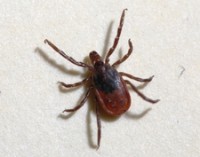Powassan Virus Confirmed in Two Putnam Residents
 Putnam County Department of Health officials were notified by the New York State Department of Health (NYSDOH) last week that two Putnam residents were positively confirmed for Powassan (POW) virus, a tick-borne illness. The two affected individuals are recovering at home.
Putnam County Department of Health officials were notified by the New York State Department of Health (NYSDOH) last week that two Putnam residents were positively confirmed for Powassan (POW) virus, a tick-borne illness. The two affected individuals are recovering at home.
POW virus, like Lyme disease, is transmitted through the bite of an infected deer (black-legged) tick. The POW virus can be transmitted in as little as 15 minutes; in contrast, most Lyme infections require the tick be attached for at least 36 to 48 hours before the bacterium can be transmitted. Since POW is a virus, antibiotics are not effective, as they are with the bacterial Lyme disease. Signs and symptoms of POW infection can include fever, headache, vomiting, weakness, confusion, seizures, and memory loss. Long-term neurologic problems may occur. People with severe POW virus illness often need to be hospitalized to receive respiratory support, intravenous fluids, or medications to reduce swelling in the brain that may occur.
Fortunately, POW virus is significantly less common than the Lyme bacterium. Since 2001, New York State has reported 16 known cases of POW; 5 of these were Putnam County residents. A recent study of ticks in the 7 Hudson Valley counties found that Putnam had the highest rate of POW virus infection. Still, the rate is low at only 3.84 percent of ticks. The research was conducted by the NYSDOH in collaboration with the Carey Institute of Ecosystem Studies, based in Millbrook, N.Y.
“Preventing tick bites is the first defense in preventing all tick-borne infections,” said Allen Beals, M.D., Commissioner of Health, “but especially important given the rapid transmission of the POW virus. This illness gives another reason to seriously consider applying a repellent containing DEET, which has been highly effective in preventing bites.”
People who frequent wooded and tall, grassy areas, such as hunters, campers, hikers, gardeners, and outdoor workers, are more likely to be exposed to ticks. The deer tick cannot fly or jump, but instead rests on low-lying vegetation and attaches to passing animals and people. The risk is greatest along trails in the woods and on the edges of properties with tall vegetation, where the higher humidity levels are ideal for tick survival. However, ticks are also carried into lawns and gardens by pets, mice and other small animals.
Decrease your chances of a tick bite by taking the following precautions:
- Tuck pants into socks and shirt into pants when in wooded and grassy areas.
- Wear light-colored clothing to spot ticks more easily.
- Check for ticks on clothing or skin frequently. Brush them off before they can attach to your skin.
- Do a thorough “tick check” of your entire body daily. Pay particular attention to the back of the knees, behind the ears, the scalp, the armpits and your back.
- Repellents containing DEET have been effective in preventing tick bites. If you decide to use a tick repellent, apply carefully and follow all label directions. Bathe or shower and change clothes when you go back inside.
- Do not apply repellents directly to children. Apply to your hands and then transfer it to the child. Never apply repellents to children’s hands or face.
- No one should apply repellents near eyes, nose or mouth.
If an attached tick is found, remove it immediately. The Health Department recommends the following method: (1) Use fine-tipped tweezers to carefully grasp the mouth-parts—not the body—of the tick, close to the skin. (2) Gently and steadily pull the tick out without twisting or squeezing. (3) Wash the bite area thoroughly. (4) Apply antiseptic.
For more information about POW virus and other tick-borne diseases, call the Putnam County Department of Health at (845) 808-1390 or visit the Centers for Disease Control and Prevention website at www.cdc.gov/powassan/
The Health Department’s mission is to improve and protect the health of the Putnam County community, composed of nearly 100,000 residents. Core services include community health assessment, disease surveillance and control, environmental health protection, family health promotion and health education. For more information, please visit our website at www.putnamcountyny.com; or visit our social media sites on Facebook at www.facebook.com/putnamhealth and Twitter @PutnamHealthNY.

Adam has worked in the local news industry for the past two decades in Westchester County and the broader Hudson Valley. Read more from Adam’s author bio here.
